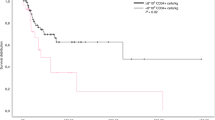Abstract
High-dose etoposide (2.0-2.4 g m(-2)) with granulocyte colony-stimulating factor (G-CSF) is an effective strategy to mobilize peripheral blood progenitor cells (PBPCs), although in some patients this is associated with significant toxicity. Sixty-three patients with malignancy were enrolled into this non-randomized sequential study. The majority (55/63, 87%) had received at least two prior regimens of chemotherapy, and seven patients had previously failed to mobilize following high-dose cyclophosphamide with G-CSF. Consecutive patient groups received etoposide at three dose levels [2.0 g m(-2) (n = 22), 1.8 g m(-2) (n = 20) and 1.6 g m(-2) (n = 21)] followed by daily G-CSF. Subsequent leukaphereses were assayed for CD34+ cell content, with a target total collection of 2.0 x 10(6) CD34+ cells kg(-1). Toxicity was assessed by the development of significant mucositis, the requirement for parenteral antibiotics or blood component support and rehospitalization incidence. Ten patients (16%) had less than the minimum target yield collected. Median collections in the three groups were 4.7 (2 g m(-2)), 5.7 (1.8 g m(-2)) and 6.5 (1.6 g m(-2)) x 10(6) CD34+ cells kg(-1). Five of the seven patients who had previously failed cyclophosphamide mobilization achieved more than the target yield. Rehospitalization incidence was significantly lower in patients receiving 1.6 g m(-2) etoposide than in those receiving 2.0 g m(-2) (P = 0.03). These data suggest that high-dose etoposide with G-CSF is an efficient mobilization regimen in the majority of heavily pretreated patients, including those who have previously failed on high-dose cyclophosphamide with G-CSF. An etoposide dose of 1.6 g m(-2) appears to be as effective as higher doses but less toxic.
This is a preview of subscription content, access via your institution
Access options
Subscribe to this journal
Receive 24 print issues and online access
$259.00 per year
only $10.79 per issue
Buy this article
- Purchase on Springer Link
- Instant access to full article PDF
Prices may be subject to local taxes which are calculated during checkout
Similar content being viewed by others
Author information
Authors and Affiliations
Rights and permissions
About this article
Cite this article
Kanfer, E., McGuigan, D., Samson, D. et al. High-dose etoposide with granulocyte colony-stimulating factor for mobilization of peripheral blood progenitor cells: efficacy and toxicity at three dose levels. Br J Cancer 78, 928–932 (1998). https://doi.org/10.1038/bjc.1998.603
Issue Date:
DOI: https://doi.org/10.1038/bjc.1998.603
This article is cited by
-
Improving stem cell mobilization strategies: future directions
Bone Marrow Transplantation (2009)
-
Patients mobilizing large numbers of CD34+ cells (‘super mobilizers’) have improved survival in autologous stem cell transplantation for lymphoid malignancies
Bone Marrow Transplantation (2007)
-
Paclitaxel-containing high-dose chemotherapy for relapsed or refractory testicular germ cell tumours
British Journal of Cancer (2004)
-
High-dose ara-C with autologous peripheral blood progenitor cell support induces a marked progenitor cell mobilization: an indication for patients at risk for low mobilization
Bone Marrow Transplantation (2002)
-
The efficacy of prophylactic outpatient antibiotics for the prevention of neutropenic fever associated with high-dose etoposide (VP-16) for stem cell mobilization
Bone Marrow Transplantation (2002)



